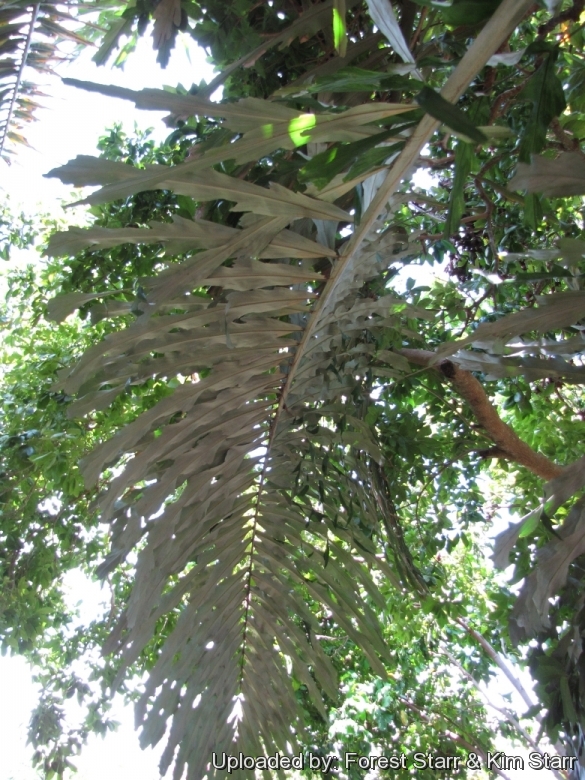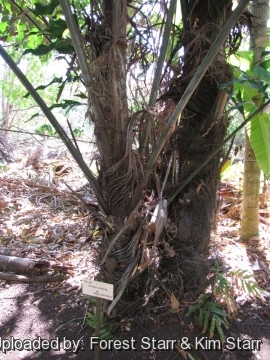Accepted Scientific Name: Arenga undulatifolia Becc.
Malesia 3: 92 (1886)

Saguerus undulatifolius (Arenga undulatifolia) Photo by: Forest Starr & Kim Starr
Frond at Iao Tropical Gardens of Maui, Maui. May 22, 2012.
Origin and Habitat: Borneo, Philippines (Palawan Island) and Indonesia (Sulawesi Island)
Habitat: Arenga undulatifoliaSN|24947]]SN|24947]] is an understory species of tropical lowland rainforests characteristic of river banks, but they do not behave as rheophytes capable of withstanding complete submergence for prolonged periods.
Synonyms:
See all synonyms of Arenga undulatifolia
back
Accepted name in llifle Database:Arenga undulatifolia Becc.Malesia 3: 92 (1886)Synonymy: 3
back
Common Names include:
ENGLISH: Batbat palm, Wild sago palm
CHINESE (中文): Bo ye guang lang
MALAY (بهاس ملاي /Bahasa Melayu ): Oren Gelora (Borneo), Kabun jaka, Kabung jaka, Aren Gelora
Description: Arenga undulatifoliaSN|24947]]SN|24947]] is a fantastic short-trunked feather-leaf palm with large wavy fronds that grows to about 4 m tall. It is a suckering species that forms dense clumps and takes up a lot of room. It is a monoecious plant, monocarpic (bearing fruit only one time during its existence).
Trunks: Short stocky occasionally 3-5 m tall but usually less than 2 m tall in cultivation, at first covered by the foliar bases and by a mass of blackish-brown fibres that persist for many years, then the lower part of the stem became bare of a dark green colour and with pale ring-like leaf scars.
Leaves: Very attractive, pinnate on a short petiole, 3 or more metres long, initially erect, and then elegantly curved, spreading quite a distance in all directions. Leaflets (pinnae) distributed uniformly on the rachis, about 60 cm long, large, wavy, ruffled, fishtail-shaped dark green with bluish reflexes above, whitish or pale grey beneath. Margin toothed and wavy.
Inflorescences: Infrafoliar, ramified, initially erect than hanging, carrying only masculine or feminine flowers, but always on the same plant.
Flowers: Male flowers are noticeable for their colour, going from the yellow to orange to brown, and for the intense spicy scent they emanate.
Fruits: Globose, of 3-4 cm of diameter, brown when ripe and usually contain three seeds.
Bibliography: Major references
1) 1) Forest & Kim Starr “Arenga undulatifolia (Aren Gelora)”. Plants of Hawaii. <http://www.starrenvironmental.com>. Downloaded on 20 August 2014.
2) Rajindra K. Puri “Deadly Dances in the Bornean Rainforest: Hunting Knowledge of the Penan Benalui” KITLV Press, 2005
3) Antonio Guerci “Il cibo e il corpo” Erga edizioni, 1999. Page 145.
 Trunk at Iao Tropical Gardens of Maui, Maui. May 22, 2012. (Arenga undulatifolia) Photo by: Forest Starr & Kim Starr
Trunk at Iao Tropical Gardens of Maui, Maui. May 22, 2012. (Arenga undulatifolia) Photo by: Forest Starr & Kim StarrSend a photo of this plant.The gallery now contains thousands of pictures, however it is possible to do even more. We are, of course, seeking photos of species not yet shown in the gallery but not only that, we are also looking for better pictures than those already present.
Read More... Cultivation and Propagation: This is one of the most ornamental tropical palm with easy to manage nature. Its undulated dark green leaves with metallic bluish reflexes and whitish lower page flicker which the least breeze and are of an incomparable beauty. It needs of ample spaces for showing its characteristics in the best way, and perhaps it is also for this reason that it is somewhat little diffused out from the places of origin. It can also be grow indoors in a container for years before out growing the pot, but looks much better when planted in the ground.
Soil: They prefers well draining, porous soils rich in humus slightly acidic or neutral. Amend the soil with organic peat moss or top soil when you plant.
Light: They do well in sunny position, but the arenga keep their best deep green colour in partial shade, if indoors place in a position where it will get some sun during the day. Seedlings like a more sheltered area.
Watering: In cultivation they appreciates abundant waterings. During the summer or warmer months, water frequently to keep the soil from drying out.
Fertilization: Need a perfect fertilizer diet including all micro nutrients and trace elements or slow release fertilizer. Apply fertilizer 3 times a year, in spring, summer and fall...and if the palm is planted in full sun, fertilize more often. In a full sun location the fronds tend to turn lime-green or yellow, so the extra fertilization helps prevent this discolouration.
Hardiness: It is cultivable in the humid tropical and subtropical climate (USDA zone 11-12), with lowest temperatures usually over the 16-18 °C, even if it may stand isolated decreases of temperatures down to 3-5 ° C for a very short time, but with detriment of the foliage. However it can be difficult to get it to look its best without a great amount of heat and sun and so it is only really suited to the tropics in frost-free regions.
Maintenance: These palms aren't considered self-cleaning but you'll only need to trim off an old frond occasionally.
Garden Use: It is a very spectacular palm suited to tropical areas and big gardens, landscape, passage, privacy screen along a patio or pool and single specimen. It has an unusual growth habit - short and wide-spreading - that makes them a great alternative to a shrub hedge, it is also an understory plant in a garden shaded by trees or taller palms, an arenga palm tends to spread less and makes an outstanding stand-alone specimen.
Food use: Arenga undulatifolia has been in the past one of the Penan's preferred tree palm for making apu 'sago starch' (an important source of carbohydrates). The fibrous inner part of the palm (pith) was extracted with a pick-axe.
It can also provide edible buds (the tender meristematic region found in the growing apex and enclosed by leaf-bases) up to 2-3 kg. Raw palm buds (a.k.a. palm cabbage) are crispy and have a light taste, they are boiled and served as a side-dish to main staples, nowadays, when cooked with beef, it is considered as a dainty and worthy to figure in the meals of the most important festivities and ceremonies.
Traditional uses: The roots of this palm were used by the natives of Palawan Island (Philippines) in making strings for their most common musical instrument.
Warning: Be aware of fruits containing caustic juice, highly irritant to human skin, it is to be handled with care, wearing gloves, if possible. In case of contact with skin or eyes wash with water immediately.
Propagation Method: Seed. The fresh seeds germinate in 4-10 weeks at the temperature of 24-28 °C; the growth is fairly fast when in the best conditions of cultivation.










